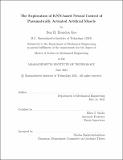The Exploration of KNN-based Neural Control of Pneumatically Actuated Artificial Muscle
Author(s)
Koo, Bon H. Brandon
DownloadThesis PDF (8.120Mb)
Advisor
Roche, Ellen T.
Terms of use
Metadata
Show full item recordAbstract
The advantages of accurately and efficiently augmenting human motion, such as locomotion and limb and load manipulation, is relatively well defined. Such augmentation attempts to aid in resolving the human limitations of energy availability, efficiency, and magnitude; well-executed human augmentation can dispatch and manipulate greater amounts of energy with lower cost, extending the available resources over a greater amount of work. These advantages are highlighted in applications pertaining to many fields, one of the most noticeable being the defense and aerospace industry uses. The energy starved and limited deployment often seen in these areas greatly benefit from being able to conserve input and amplify output by its personnel. For example, the increasing loads required to be carried and manipulated by soldiers, especially in recent conflicts, as well as the crippling energy cost of operating an Extra-vehicular Mobility Unit (EMU) worn by astronauts are one of many use cases that highlight an increasing need for a streamline and efficient solution for the augmentation of human motion under extreme environments.
The potential solution for these issues, suggested in this thesis, is the development of an exoskeleton. However, such a device must tackle a delicately interwoven two-part problem which must be addressed individually; what actuation is the user controlling, and how the user is controlling these actuators. In this thesis, we present the groundwork of addressing both of these problems through a parallel effort of prototyping, modelling, and experimenting for a promising method of neural control through K-Nearest Neighbor (KNN) sorting and the incremental development of a biomimetic actuator in the form of Pneumatic Artificial Muscles (PAMs).
KNN classification is a lightweight non-parametric learning algorithm that can rapidly identify and sort an input into pre-determined categories given initial training data sets. In this thesis, I present a method of using KNN classification to sort neural impulse data, collected through surface Electromyography (sEMG) on select muscle groups to predict the kind and magnitude of motion before/as a motion is executed by the human upper limb muscles. EMG data on 6 muscle groups, all in the arm/shoulder region, while performing one of 2 speeds of 6 motions (totalling 12 independent motions) were collected and real-time processed for key landmark features, which were then presented to the KNN algorithm as training data. It appears that the KNN sorting, based on the inputted training data, was sufficient to not only identify the type of motion presented, but also the magnitude of motion between the two magnitudes trained. Although the validity of considering this as a prediction is not clear in this thesis due to the lack of time-scale data relative to real motion, the KNN was capable of executing such sorting processes well within a time-frame that can be regarded as practically instant compared to human reaction times.
PAMs show great promise as a substitute to rotary and linear actuation methods commonly used in exoskeletons and other biomimetic devices due to its mechanical similarity to human muscle; specifically, PAMs are a closer analog to myocytes than most other form of rotary/linear actuator utilized in exoskeleton applications today. The length and stiffness behavior is extremely similar to that of human muscles on a cellular level, and motor units can also be simulated through the usage of multiple PAMs in parallel. Such similarities allow for many muscular behaviors to be mimicked. Specifically, this thesis explores the potential of PAMs to accurately portray the well documented emergent muscular behavior of the Henneman's size principle, with the underlying hypothesis that states that a higher fidelity of biomimetic replication will lead to a more seamless and transparent exoskeleton device featuring higher perceived invisibility. Through prototyping and simulating multiple configurations of PAMs, this study shows the performance they can provide in single and group organizations, along with comparisons between the prototype PAM behavior and human muscle performance. Finally, this study suggests potential for the PAM's real-world deployment through simulating a realistic task utilizing these biomimetic properties.
Furthermore, this thesis lays down a projected research path for these potential solutions moving forward. The KNN classification prediction model of muscle motion through the analysis of sEMG data in conjunction with further developments in increasing the production capabilities, stability, performance, and form factors of PAMs as actuators show great promise as a human augmentation exoskeleton platform.
Date issued
2021-06Department
Massachusetts Institute of Technology. Department of Mechanical EngineeringPublisher
Massachusetts Institute of Technology